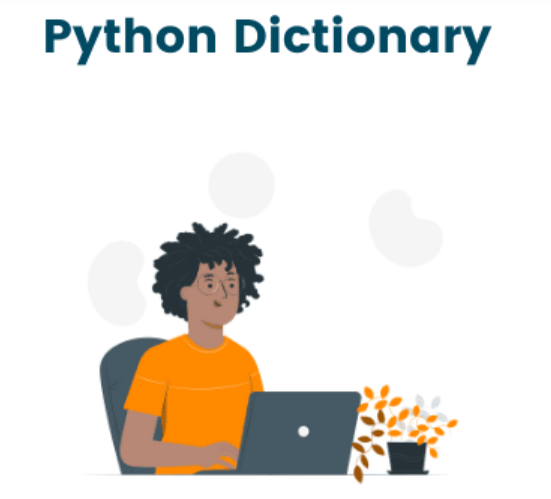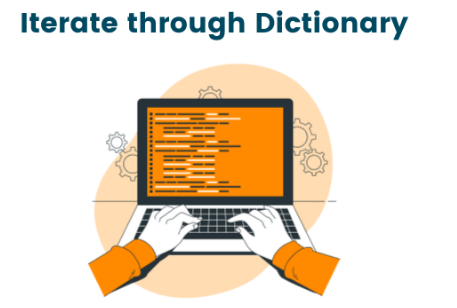Iterating over a dictionary in Python is a fundamental skill that allows you to efficiently access and manipulate key-value pairs within this versatile data structure. By iterating through a dictionary, you can perform various operations, such as extracting values, updating information, or applying specific logic to each key-value pair. This process is crucial for handling and processing data efficiently in Python programs, providing a dynamic way to interact with the contents of a dictionary. In the following discussion, we will explore different methods and techniques for iterating over dictionaries.

How to Iterate Over a Dictionary in Python
Iterating through a dictionary means going through each key-value pair one by one. It’s a crucial task if you want to use a dictionary properly in Python.
To do this, there are several commonly used methods for dictionary iteration:
- Use keys() to iterate through keys.
- Use .values() to go through all values.
- Use items() to iterate through key-value pairs.
- Employ a for loop to loop through the dictionary.
- Access keys using map() and dict.get.
- Access keys in Python using zip().
- Access keys through the unpacking of a dictionary.

These methods provide various ways to navigate and work with the contents of a dictionary, giving you flexibility in handling data in your Python programs.
Use keys() to iterate through keys
Using the keys() method in Python allows you to iterate through the keys of a dictionary, providing a straightforward way to access and manipulate the dictionary’s structure. This method returns a view object that displays a list of all the keys in the dictionary.
Here’s a simple example demonstrating how to use keys() for dictionary iteration:
# Define a sample dictionary
fruit_prices = {'apple': 1.0, 'banana': 0.75, 'orange': 1.5, 'grape': 2.0}
# Iterate through keys using keys()
for fruit in fruit_prices.keys():
print(f"The price of {fruit} is {fruit_prices[fruit]} dollars.")In this example, we have a dictionary fruit_prices with fruit names as keys and their corresponding prices as values. The keys() method is utilized in the for loop to iterate through each key (fruit) in the dictionary. Inside the loop, we access the corresponding value using the key and print the fruit along with its price.
By using keys(), you efficiently traverse the keys of the dictionary, making it a convenient method for tasks that specifically involve working with the keys themselves.
Use .values() to go through all values
Utilizing the values() method in Python provides a straightforward approach to iterate through all the values of a dictionary. This method returns a view object containing all the values present in the dictionary, allowing you to access and manipulate the data without explicitly dealing with the keys.
Let’s explore a practical example of how to use values() for dictionary iteration:
# Define a sample dictionary
fruit_prices = {'apple': 1.0, 'banana': 0.75, 'orange': 1.5, 'grape': 2.0}
# Iterate through values using values()
for price in fruit_prices.values():
print(f"The price of a fruit is {price} dollars.")In this example, the dictionary fruit_prices associates fruit names with their respective prices. The values() method is employed in the for loop to iterate through each value in the dictionary. Inside the loop, we print a statement that incorporates the current price.
By utilizing values(), you can efficiently traverse through all the values of the dictionary, making it particularly useful when your task involves working with the values directly rather than the associated keys. This method enhances the flexibility of dictionary manipulation in Python.
Use items() to iterate through key-value pairs
The items() method in Python is a powerful tool for iterating through key-value pairs in a dictionary. It provides a convenient way to access both the keys and their corresponding values simultaneously, allowing for effective manipulation of the entire dictionary structure.
Let’s delve into a practical example to showcase how to use items() for dictionary iteration:
# Define a sample dictionary
fruit_prices = {'apple': 1.0, 'banana': 0.75, 'orange': 1.5, 'grape': 2.0}
# Iterate through key-value pairs using items()
for fruit, price in fruit_prices.items():
print(f"The price of {fruit} is {price} dollars.")
In this example, the dictionary fruit_prices contains fruit names as keys and their corresponding prices as values. The items() method is employed in the for loop to iterate through each key-value pair. Inside the loop, the variables fruit and price are used to represent the current key and its associated value, respectively. This allows us to print a statement that includes both the fruit name and its price.
By using items(), you gain a concise and efficient way to navigate through the entire dictionary, extracting both keys and values as needed. This method is particularly useful when your task requires simultaneous access to both components of each key-value pair.
Employ a for loop to loop through the dictionary
Using a for loop in Python is a versatile and fundamental technique for iterating through a dictionary. This approach provides a straightforward means of accessing each key in the dictionary, enabling effective manipulation of the data stored within.

Let’s illustrate the usage of a for loop to loop through a dictionary with a practical example:
# Define a sample dictionary
fruit_prices = {'apple': 1.0, 'banana': 0.75, 'orange': 1.5, 'grape': 2.0}
# Loop through the dictionary using a for loop
for fruit in fruit_prices:
print(f"The price of {fruit} is {fruit_prices[fruit]} dollars.")In this example, the dictionary fruit_prices contains fruit names as keys and their corresponding prices as values. The for loop is employed to iterate through each key in the dictionary. Inside the loop, the variable fruit represents the current key, allowing us to access the corresponding value using fruit_prices[fruit]. We then print a statement that includes both the fruit name and its price.
Utilizing a for loop in this manner simplifies the process of iterating through a dictionary, providing a clean and efficient way to access and manipulate the data it holds. This technique is particularly useful when you are primarily interested in working with the keys of the dictionary.
Access keys using map() and dict.get
In Python, you can access the keys of a dictionary using the map() function along with dict.get(). This combination provides a concise and efficient way to apply a function to each key in the dictionary, generating a new iterable containing the results.
Let’s illustrate this approach with a practical example:
# Define a sample dictionary
fruit_prices = {'apple': 1.0, 'banana': 0.75, 'orange': 1.5, 'grape': 2.0}
# Use map() and dict.get() to access keys
keys_result = map(fruit_prices.get, fruit_prices)
# Convert the result to a list for visualization
keys_list = list(keys_result)
# Print the keys obtained using map() and dict.get()
print("Keys obtained using map() and dict.get():", keys_list)In this example, the map() function is applied to the fruit_prices.get method, which retrieves the value for each key in the dictionary. The result is then converted into a list for better visualization. This list, keys_list, contains the keys of the fruit_prices dictionary.
Using map() in conjunction with dict.get() is a powerful approach when you need to perform an operation on each key of the dictionary and obtain the results in a new iterable. It enhances the flexibility of working with dictionaries in a concise and expressive manner.
Access keys in Python using zip()
In Python, the zip() function offers an efficient method to access keys from a dictionary. By using zip() in conjunction with the dictionary’s keys, you can create pairs of keys and their corresponding values. This approach provides a convenient way to iterate through the keys without directly accessing the dictionary.
Let’s dive into a practical example to demonstrate how to access keys using zip():
# Define a sample dictionary
fruit_prices = {'apple': 1.0, 'banana': 0.75, 'orange': 1.5, 'grape': 2.0}
# Access keys using zip()
keys_result = list(zip(fruit_prices.keys()))
# Print the keys obtained using zip()
print("Keys obtained using zip():", keys_result)In this example, the zip() function applies to fruit_prices.keys(), creating pairs of keys and their corresponding values. By converting the result into a list, the keys_result variable contains the keys of the fruit_prices dictionary.
Using zip() provides a clean and concise way to access keys, and it is especially handy when you want to work with key-value pairs as tuples. This method enhances the flexibility of iterating through dictionary keys in a manner that is both readable and expressive.
Access keys through the unpacking of a dictionary
In Python, you can access keys from a dictionary through the process of unpacking. This involves extracting the keys directly from the dictionary and working with them individually. Unpacking allows for a straightforward and efficient way to access and iterate through the keys without explicitly calling any specific method.
Let’s explore a practical example to illustrate how to access keys through the unpacking of a dictionary:
# Define a sample dictionary
fruit_prices = {'apple': 1.0, 'banana': 0.75, 'orange': 1.5, 'grape': 2.0}
# Access keys through dictionary unpacking
keys_result = [*fruit_prices]
# Print the keys obtained through unpacking
print("Keys obtained through unpacking:", keys_result)In this example, the syntax [*fruit_prices] unpacks the dictionary, extracting all its keys. The resulting keys_result contains a list of the keys from the fruit_prices dictionary.
Unpacking provides a concise and readable way to access keys, and it is particularly useful when you want a simple list of keys without the need for additional methods or functions. This approach enhances the clarity and expressiveness of your code when working with dictionaries in Python.
Conclusion
In conclusion, knowing how to go through a dictionary in Python is crucial for working with data. We’ve explored different ways, like using keys(), values(), and items(), or employing techniques such as for loops, map(), dict.get(), zip(), and unpacking.
These methods provide diverse ways to handle dictionaries, allowing you to pick the one that fits your needs best. Learning how to iterate over dictionaries is a key skill that makes working with data in Python much easier, whether you’re new to programming or already experienced. It’s like having a powerful tool to navigate and manipulate information effectively in your Python programs.
Ready to elevate your Python skills? Join our FREE Python Course today and unlock your potential in programming and data science!
You can read more articles related to Python Dictionaries:
- Working with Lists & Dictionaries in Python
- Understand the Concept of Dictionary
- Top Interview Questions on Dictionary in Python
Frequently Asked Questions
A: You can use a for loop to iterate over the keys of a dictionary.
Example:
my_dict = {‘a’: 1, ‘b’: 2}
for key in my_dict:
print(key)
A: The keys() method can be used to get an iterable of keys for a dictionary.
Example:
my_dict = {‘a’: 1, ‘b’: 2}
for key in my_dict.keys():
print(key)
A: You can use a for loop to iterate over the values of a dictionary.
Example:
my_dict = {‘a’: 1, ‘b’: 2}
for value in my_dict.values():
print(value)
A: Yes, the values() method can be used to get an iterable of values for a dictionary.
Example:
my_dict = {‘a’: 1, ‘b’: 2}
for value in my_dict.values():
print(value)
A: You can use a for loop to iterate over the items of a dictionary, which returns key-value pairs. Example:
my_dict = {‘a’: 1, ‘b’: 2}
for key, value in my_dict.items():
print(f’Key: {key}, Value: {value}’)





